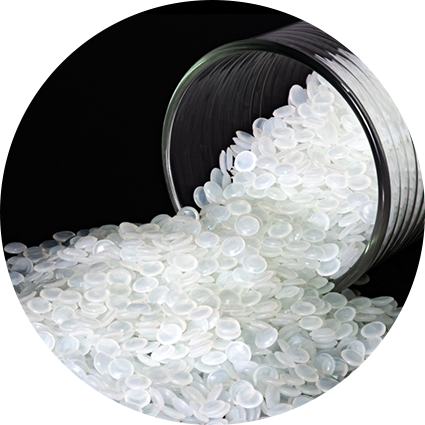Fully biodegradable film is a high-performance environmentally friendly material made from renewable resources. The main raw materials include polylactic acid (PLA), PBAT, starch-based materials, etc. In the natural environment, this type of film can be completely decomposed into water and carbon dioxide under the action of microorganisms, without toxic residues, truly realizing "restore after use", without pollution to soil and water, and avoiding the long-term trouble of "white pollution".
Compared with traditional plastic films, fully biodegradable films not only have good physical properties, such as tensile resistance, tear resistance, and excellent barrier properties, but also take into account environmental protection, safety and sustainability.
Comparison of fully biodegradable film and traditional plastic film:
| Comparison Item |
Fully Biodegradable Film |
Traditional Plastic Film |
| Raw Material Source |
Renewable bio-based materials (PLA, PBAT, starch, etc.) |
Petroleum-based synthetic polymers (PE, PP, PVC, etc.) |
| Degradability |
Fully degradable by microorganisms into water and CO₂, with no harmful residues |
Difficult to degrade; accumulates in the environment, causing white pollution |
| Environmental Impact |
Non-polluting to soil and water; supports sustainable development |
Long-term pollution to soil and water; harms ecosystems |
| Physical Properties |
Excellent tensile strength, tear resistance, and barrier performance; suitable for packaging |
High strength and durability; widely used in packaging and protection |
| Safety |
Free of toxic additives; environmentally safe |
May contain additives; potential safety risks during use and recycling |
| Processing Methods |
Compatible with mainstream film production processes (blown film, casting, heat sealing) |
Wide application range; mature processing technologies |
| Application Areas |
Green packaging, agricultural films, disposable products |
Food packaging, industrial packaging, daily-use packaging |
| Recyclability |
Compostable or biodegradable; promotes circular resource use |
Low recycling rate; often ends up in landfills or incinerators, causing secondary pollution |
| Cost |
Relatively high; decreasing with technological advancement |
Low cost; high market penetration |
Wide application scenarios, green substitution is accelerated
In practical applications, fully biodegradable film has been widely used in the following fields:
| Application Area |
Usage Form |
Environmental Value Description |
| Industrial Packaging |
Stretch film, shrink film, laminated bags |
Leaves no residue after degradation; suitable for green export standards |
| Retail Packaging |
Supermarket shopping bags, courier bags, garment bags |
Replaces traditional PE bags; complies with environmental regulations in many countries |
| Agricultural Film |
Mulch film, seedling bags |
No need for retrieval after degradation; reduces labor and soil pollution |
| Medical & Electronics |
Anti-static packaging, disposable packaging materials |
Ensures hygiene and safety while addressing packaging waste issues |
Among them, in the field of industrial packaging, fully biodegradable film is widely used in the transportation packaging of electronic products, mechanical parts, hardware products, etc. with its high strength and good flexibility. It can provide necessary protection without causing continuous burden on the environment, and has become an important material for export companies to cope with environmental protection standards such as Europe.
In what aspects does fully biodegradable film perform well?
As a new generation of environmentally friendly materials, fully biodegradable film is becoming an ideal alternative to traditional plastic film with its excellent environmental performance and excellent physical properties. It is not only made of renewable bio-based raw materials, but also can be completely degraded by microorganisms in the natural environment, realizing the real "restore after use", effectively reducing the long-term impact of plastic pollution on the ecological environment; at the same time, its strength, flexibility and transparency meet or even exceed the application requirements of traditional plastic films. In addition, this film is compatible with a variety of mainstream processing technologies, which is convenient for enterprises to quickly switch production lines, reduce transformation costs, and help the green upgrading and sustainable development of the industry.
Green and environmentally friendly, fully degradable: Made of natural or renewable bio-based materials such as PLA (polylactic acid), PBAT, and starch-based materials, the film can be naturally degraded by microorganisms in a composting environment or soil, and eventually converted into water and carbon dioxide, without any toxic residues or microplastic pollution. Compared with traditional PE and PP films, it has no long-term damage to soil, water sources and ecosystems, and is an important material for achieving green and sustainable development, helping companies reduce "white pollution" from the source.
Excellent physical properties: Although derived from natural materials, the product performs well in strength, flexibility and transparency. It has excellent tensile properties and tear resistance, and can be used for common packaging applications such as load-bearing, sealing, and compression resistance. At the same time, it has high transparency and soft feel, and is suitable for outer packaging of goods with high requirements for aesthetics and user experience. It is an ideal substitute for traditional plastics, taking into account both environmental protection and practicality.
Adaptable to a variety of processing technologies: The film material can be widely used in mainstream film production and processing methods, including film blowing, casting, heat sealing, laminating, printing and other processes, and can be quickly integrated into existing production lines without the need for major equipment replacement or additional investment. For enterprises, the transformation threshold is low and the operating procedures are familiar, which greatly reduces the technical and economic burden that may be brought about by the process of replacing environmentally friendly materials.










